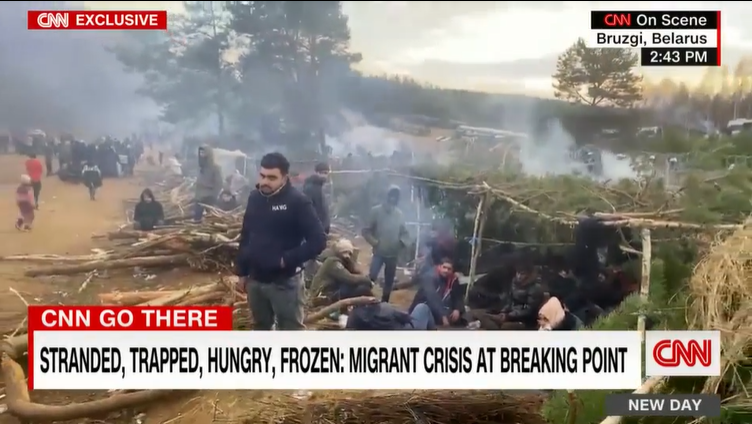
Update:
Anne Applebaum at The Atlantic starts her fascinating reportage on the crisis at the Belarus border as follows:
A small Kurdish boy is sitting on the ground in a damp Polish forest, a few miles from the eastern border with Belarus. The air is heavy with cold and fog. The boy is crying.
Around the boy, sitting in a circle, are his parents, uncles, and cousins, all from the same village near Dohuk, in Iraqi Kurdistan. There are 16 of them, among them seven children, including a four-month-old infant and an elderly woman who can scarcely walk. They don’t speak Polish, or English. One of the boy’s relatives, a man named Anwar, speaks Arabic. Through a translator, Anwar says that the family has been in this forest, moving back and forth between Poland and Belarus, for two weeks. They have eaten nothing for the previous two days.
She concludes with this:
But I began with a single Kurdish boy for a reason, so let me end with him too. For the truth is that almost everyone with an interest in perpetuating this crisis, or in taking advantage of this crisis, or in profiting politically from this crisis doesn’t want you to see him. They want you to see masses, migrants, or Muslims robbed of humanity and lacking faces and names. They want you to see “waves” of people, “hordes” of people, anonymous migrants who have allowed themselves to become bullets in a hybrid war. But a mass tragedy is really just a set of individual tragedies. Remember that when you see one starting to unfold.
To read everything in between — a captivating, incisive, heartbreaking account — please click here or here
Original Post:
Humans, animals, objects have been used as weapons of war for eons.
However, the increased use of the terms “weaponizing” and “weaponization” in our lexicon is a recent phenomenon
Its first use is frequently attributed to rocket engineer and space visionary Wernher von Braun who in the late 50s vigorously advocated the militarization, the “weaponization” of space.
The world’s promise not to weaponize space has since been tenuously honored “in principle” and by ‘interpretation.” However,, “[a]s a result of [interpretation of the Outer Space Treaty], outer space is nowadays crawling with satellites used for military purposes such as intelligence gathering, reconnaissance, navigation, targeting over battlefields, early warning of missile and air attacks, or military communications, usually without protest from the international community.”
On the other hand, mankind has “excelled” in the weaponization of practically all other spaces, objects, organisms and creatures.
We have seen horrific proliferation in the conversion of innocuous objects, all kinds of animals, unsuspecting or coerced human beings into weapons of war.
Man has now succeeded in weaponizing artificial intelligence, cyber space, (dis)information (“Weaponized narrative“) , language and social media
Some groups and states have even weaponized hunger and thirst.
In “If Everything Can Be ‘Weaponized,’ What Should We Fear?,” John Herrman writes, referring to the recent deterioration of our political discourse, how political news — “racehorse philosophy” — “is now turning away from a language of sports and toward a language of war. The horse race has given way to an arms race, in which everything, and everyone, have the potential to be ‘weaponized.’”
One of the most cynical, gruesome forms of weaponization certainly has to be the use of desperate, destitute migrants and refugees by nations or non-state actors to overwhelm, cause economic or political damage, provoke turmoil and instability in other countries.
In a 2011 New York Times column discussing Libya’s Qaddafi’s threatened use of “demographic bombs,” Kelly Greenhill notes that “there were at least 56 attempts to employ the direct or indirect threat of mass migrations as a non-military instrument of influence between 1951 and 2006.”
In 2016, after the indiscriminate mass bombing of civilians in Syria by Syrian forces — with Russian support — that caused a mass exodus of refugees, “desperate for food, shelter and safety,” toward Europe, Philip Breedlove, the supreme allied commander in Europe told the Senate Armed Services Committee, “Together, Russia and the Assad regime are deliberately weaponizing migration in an attempt to overwhelm European structures and break European resolve.”
In his 2017 thesis, “The Weaponization of Migration: Examining Migration as a 21st Century Tool of Political Warfare,” U.S. Army Major Nathan D. Steger sub-classifies this form of “weaponized migration” as “exportive migration,”…another technique that governing entities have used to solidify power or, in some cases, to destabilize adversaries.”
In the 16 cases of exportive migration examined by Steger for the period 2007-2017, “50% (8/16) attempted to destabilize adversaries by exporting migrants.”
Steger cites Iran’s massive deportations back to Afghanistan of Afghans who had sought refuge in Iran after the Soviet invasion as a recent example of exportive migration to destabilize a country.
These days, the weaponization of migrants is sadly rearing its despicable head once more. This time in Belarus where the Russian-leaning government has enticed, lured, facilitated for thousands of despairing migrants from the Middle East to travel to Belarus by loosening its visa rules — sometimes allowing migrants to board flights without visas or issuing group visas – by increasing the number of flights by its state-owned airline and other airlines, and even by putting up migrants “in at least three government-owned hotels” in Minsk.
Once in Belarus, however, the duped migrants are funneled by Belarusian security forces towards the borders with Poland, Latvia and Lithuania, instructed on how to cross the borders “even handing out wire cutters and axes to cut through border fences.”
Today, thousands of these desperate men, women and children are languishing at the borders, huddled under inhumane, freezing conditions “not wanted by the European Union countries or, circumstances are making clear, by the country that lured them there in the first place.”
Worse, when migrants try “to leave the frigid forest to return to Minsk, many have been pushed back by Belarusian guards, leaving the migrants stuck at the border…”
Some call what Belarus is doing “laying tinder for a war,” wondering how NATO will respond.
Above all, one has to wonder — recoil — how nations can sink to such depravity in pursuit of egocentric, totalitarian goals.
















